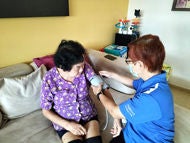What is - Epididymitis
What is epididymitis?
Epididymitis is the inflammation of the epididymis, a convoluted tube situated at the rear of the testicle.

The epididymis is part of the male reproductive system and serves as a site for the maturation, storage and, transportation of sperm.
What are the types of epididymitis?
- Acute epididymitis: Sudden onset of symptoms, often caused by a bacterial infection
- Chronic epididymitis: Long-term inflammation lasting more than six weeks, usually less severe but persistent
- Non-infectious epididymitis: Caused by irritation rather than infection, possibly due to trauma or urine reflux
- Granulomatous epididymitis: Rare and typically due to immune reactions, often seen in tuberculosis cases
Symptoms of Epididymitis
What are the symptoms of epididymitis?
Symptoms of epididymitis may include:
- An enlarged, red or warm testicle
- Tenderness or pain in the affected testicle
- A feeling of heaviness in the involved testicle
- Low-grade fever
There may be other associated symptoms such as pain in the abdomen or pelvis, frequent urge to urinate, burning sensation when urinating, discharge from the penis, blood in the urine, and pain when ejaculating.
Epididymitis often involves a slow and gradual onset of scrotal pain and swelling, developing over several days. This contrasts with conditions like testicular torsion, which have a sudden and severe onset over just a few hours.
When should you see a doctor?
- A lump or swelling in your testicles
- Changes in the shape or texture of your testicles
- Unusual sensations in your testicles
- Noticeable asymmetry, such as one testicle becoming more prominent than the other
- Persistent aching or discomfort in your testicles that does not subside
What are the potential complications of epididymitis?
- Chronic epididymitis: Epididymitis lasting more than six weeks or recurring frequently is categorised as chronic. This type of inflammation may persist even without a bacterial infection, causing long-term discomfort.
- Potential for permanent damage: Persistent inflammation can lead to permanent damage to the epididymis and, in some cases, the testicle, potentially affecting fertility.
- Abscess formation: A pus-filled collection may develop within the epididymis or surrounding structures, often necessitating surgical drainage.
- Spread of infection: The infection can extend beyond the scrotum, potentially impacting other areas of the body and leading to broader health complications.
Epididymitis - How to prevent
How is epididymitis prevented?
While not all cases of epididymitis are preventable, certain steps can reduce the risk of developing the condition:
- Practice safe sex: Use barrier protection such as condoms to lower the risk of sexually transmitted infections that may lead to epididymitis.
- Manage urinary health: Address any recurrent urinary tract infections with medical guidance as untreated infections can spread to the epididymis.
- Stay vigilant with medications: Some medications such as amiodarone can cause epididymitis. Consult a healthcare provider if you experience side effects.
- Seek timely treatment: Promptly address any pain, swelling or symptoms of infection in the genital area to prevent further complications.
Epididymitis - Causes and Risk Factors
What causes epididymitis?
- Bacterial infections: Often Sometimes due to sexually transmitted infections like chlamydia or gonorrhoea
- Urinary tract or prostate infections: These infections can spread to the epididymis
- Trauma or injury: Physical damage to the groin area can lead to inflammation
- Certain medications: Drugs like amiodarone may irritate or inflame the epididymis
What are the risk factors for epididymitis?
- Unprotected sexual activity: Increases the risk of infections that may lead to epididymitis
- Recent urinary tract surgery or catheter use: Procedures involving the urinary tract can introduce bacteria
- Structural abnormalities: Anomalies in the urinary tract can contribute to infection
- Frequent urinary tract infections: Recurrent infections raise the likelihood of epididymis inflammation
- Certain medications: Some drugs may irritate the epididymis and increase risk
Diagnosis of Epididymitis
How is epididymitis diagnosed?
The diagnosis of epididymitis may involve the following:
- Medical examination: The doctor will ask about symptoms such as the onset and duration of pain, swelling or discomfort in the genital area, and will examine the scrotum and testicles for swelling, tenderness and any changes in size or texture.
- Ultrasound of the testes: Ultrasound is the preferred diagnostic tool with high sensitivity, providing detailed information on size, shape and blood flow to help distinguish between epididymitis and conditions like testicular torsion.
- Urine tests: A urine sample may be taken to check for infection.
- Blood tests: Elevated white blood cell counts or inflammation markers in the blood may indicate an infection and aid in assessing the condition's severity.
Treatment for Epididymitis
How is epididymitis treated?
The treatment of epididymitis may involve the following:
Antibiotics
Antibiotics play a vital role in treating epididymitis caused by bacterial infections.
The choice of the antibiotic depends on the suspected causative bacteria, local resistance patterns and the patient's individual health considerations.
Pain management
Analgesia or painkillers such as NSAIDs may be prescribed to bring down pain and swelling associated with epididymitis.
Surgery
Surgery is not the first-line treatment for epididymitis. However, surgical intervention may be considered in certain situations or if complications arise.
- In cases where epididymitis leads to the formation of an abscess (a collection of pus), surgical drainage may be necessary. This procedure involves removing the accumulated pus to alleviate symptoms and promote healing.
- When other measures have been exhausted, the surgical removal of all or part of the epididymis and/or testis may be considered.
FAQs on Epididymitis
Men of any age can develop epididymitis. For those under 35 who are sexually active, it may be caused by sexually transmitted infection. On the other hand, for older men, the cause may be from common organisms involved in urinary tract infection.
In some cases, untreated or severe epididymitis can lead to complications that may impact fertility. However, prompt and appropriate treatment can help prevent such complications.
Yes, it is possible for epididymitis to recur, especially if the underlying risk factors or causes are not addressed. Completing the prescribed course of antibiotics and addressing any contributing factors can help lower the risk of recurrence.
References
Çek, M., Sturdza, L., & Pilatz, A. (2017). Acute and Chronic Epididymitis. European Urology Supplements, 16(4), 124–131. https://doi.org/10.1016/j.eursup.2017.01.003
Lee, C. T., Thirumoorthy, T., Lim, K. B., & Sng, E. H. (1989). Epidemiology of acute epididymo-orchitis in Singapore. Annals of the Academy of Medicine, Singapore, 18(3), 320–323.
American Academy of Family Physicians. (2009). Epididymitis and Orchitis: An Overview. https://www.aafp.org/pubs/afp/issues/2009/0401/p583.html
Epididymitis - epididymitis. MSD Manual Professional Edition. (n.d.). https://www.msdmanuals.com/professional/genitourinary-disorders/penile-and-scrotal-disorders/epididymitis
Epididymitis: Advocate health care. Advocate Health. (n.d.). https://www.advocatehealth.com/health-services/urology/epididymitis
Centers for Disease Control and Prevention. (2021, July 22). Epididymitis - STI treatment guidelines. Centers for Disease Control and Prevention. https://www.cdc.gov/std/treatment-guidelines/epididymitis.htm
Yonso, M. (2022). Epididymitis with abscess formation. Radiopaedia.Org. https://doi.org/10.53347/rid-96918
The information provided is not intended as medical advice. Terms of use. Information provided by SingHealth.




















